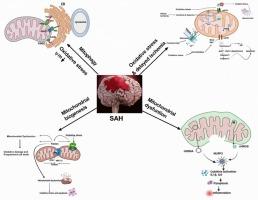Mitochondrial health and redox imbalance in the context of learning and memory in post-subarachnoid haemorrhage: therapeutic strategies for recovery
IF 2.6
4区 医学
Q3 NEUROSCIENCES
引用次数: 0
Abstract
Subarachnoid hemorrhage constitutes 5–10% of all strokes and is a subtype of hemorrhagic stroke that imposes a significant financial burden on medical care because it often affects younger people and has a high mortality rate with few treatment choices and poor patient outcomes. Preventing rebleeding, treating SAH patients as soon as possible, and preventing delayed cerebral ischemia (DCI) are important objectives during early brain injury (EBI) or first 72 hrs. Cerebral vasospasm and DCI continue to be issues despite surgical advances, particularly in older patients. A delayed diagnosis can result in DCI, which is linked to redox imbalance or oxidative stress (O.S) that causes learning-memory deficit, inflammation, apoptosis, mitophagy, disruption to the blood–brain barrier, and other detrimental processes that exacerbate these disorders. Individuals over 50 are susceptible to SAH, and as we age, our body’s excessive oxidative stress increases our risk of hemorrhagic stroke. This review highlights innovative approaches that target mitochondria for the treatment of SAH and emphasizes their role in learning, memory, EBI and DCI post-SAH, as well as their therapeutic potential.

蛛网膜下腔出血后学习和记忆的线粒体健康和氧化还原失衡:恢复的治疗策略
蛛网膜下腔出血占所有中风的5-10%,是出血性中风的一种亚型,对医疗保健造成了重大的经济负担,因为它通常影响年轻人,死亡率高,治疗选择少,患者预后差。预防再出血,尽早治疗SAH患者,防止延迟性脑缺血(DCI)是早期脑损伤(EBI)或前72小时的重要目标。尽管手术进展,尤其是老年患者,脑血管痉挛和DCI仍然是问题。延迟诊断可能导致DCI,这与氧化还原失衡或氧化应激(os)有关,后者导致学习记忆缺陷、炎症、细胞凋亡、线粒体自噬、血脑屏障破坏以及其他加剧这些疾病的有害过程。50岁以上的人容易患SAH,随着年龄的增长,我们身体过度的氧化应激增加了出血性中风的风险。这篇综述强调了针对线粒体治疗SAH的创新方法,并强调了线粒体在SAH后学习、记忆、EBI和DCI中的作用,以及它们的治疗潜力。
本文章由计算机程序翻译,如有差异,请以英文原文为准。
求助全文
约1分钟内获得全文
求助全文
来源期刊

Brain Research
医学-神经科学
CiteScore
5.90
自引率
3.40%
发文量
268
审稿时长
47 days
期刊介绍:
An international multidisciplinary journal devoted to fundamental research in the brain sciences.
Brain Research publishes papers reporting interdisciplinary investigations of nervous system structure and function that are of general interest to the international community of neuroscientists. As is evident from the journals name, its scope is broad, ranging from cellular and molecular studies through systems neuroscience, cognition and disease. Invited reviews are also published; suggestions for and inquiries about potential reviews are welcomed.
With the appearance of the final issue of the 2011 subscription, Vol. 67/1-2 (24 June 2011), Brain Research Reviews has ceased publication as a distinct journal separate from Brain Research. Review articles accepted for Brain Research are now published in that journal.
 求助内容:
求助内容: 应助结果提醒方式:
应助结果提醒方式:


